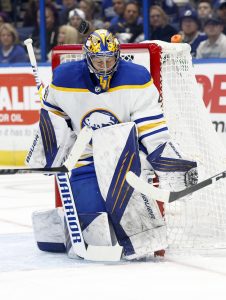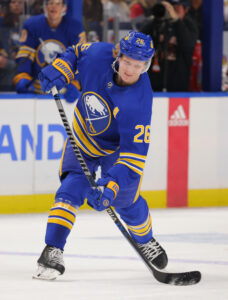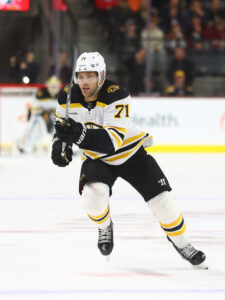For the 12th season in a row, the Buffalo Sabres failed to make the playoffs at the end of the regular season. However, for the first time in several years, the end of the regular season did matter quite a lot to the Sabres. Being one of the best scoring teams throughout the year, Buffalo finished one point back of the last wild card spot in the Eastern Conference, raising expectations for the upcoming 2023-24 NHL season. There are still some weak spots in the lineup, but the Sabres made some moves this summer to address other areas of need.
Draft
1-13: F Zach Benson, Winnipeg (WHL)
2-39: F Anton Wahlberg, IF Malmo (SHL)
2-45: D Maxim Strbak, Sioux Falls (USHL)
3-86: D Gavin McCarthy, Muskegon (USHL)
4-109: F Ethan Miedema, Kingston (OHL)
5-141: G Scott Ratzlaff, Seattle (WHL)
6-173: D Sean Keohane, Dexter School (USHS)
7-205: D Norwin Panocha, Eisbaren Berlin (DNL U20)
Benson becomes the prize of the draft for the Sabres, falling to Buffalo at 13th overall after being projected to go in the top 10 throughout much of the year. Now joining former Sabres’ first-round selection, Matthew Savoie, with the Wenatchee Wild of the WHL for the 2023-24 season, Benson capped off his three-year career with the Winnipeg Ice scoring 36 goals and 62 assists in 60 games.
Strbak and McCarthy represent solid young defenders that the team has been craving over the last several years. Both players will join the NCAA for the 2023-24 season, Strbak to Michigan State University, and McCarthy to Boston University. They both carry solid skating ability, with an even better ability to get the puck out of their zone and into transition. Overall, factoring in the team’s need to keep the puck out of their net, McCarthy likely projects as the best long-term solution to that problem.
Key UFA Signings
D Kale Clague (one year, $775K)*
D Connor Clifton (three years, $10MM)
G Devin Cooley (one year, $775K)*
D Erik Johnson (one year, $3.25MM)
F Tyson Jost (one year, $2MM)
F Justin Richards (one year, $775K)*
G Dustin Tokarski (one year, $775K)*
*-denotes two-way contract
Even with an abundance of cap space heading into the offseason, the Sabres stayed relatively quiet on the free-agent market. They were quick to address their lack of defensive prowess on the back end by inking Clifton and Johnson to contracts on day one and even brought back Jost on a one-year deal to fill the gap left by the injury to Jack Quinn.
Although finished the 2022-23 regular season as the third-highest-scoring team in the league, the Sabres finished 26th in goals against, largely due to inefficient defensemen and goaltending. By bringing in Clifton and Johnson, who both play on the right side, Buffalo should dramatically improve the quality of their blue line. Both players finished with a solid oiSV% last season at 93.2% and 91.7%, respectively.
Already carrying solid defensemen such as Rasmus Dahlin, Owen Power, and Mattias Samuelsson with the ability to play on the left side of the blue line, the additions of Clifton and Johnson immediately make the team more well-rounded. If their offense can at the very least repeat the goal-scoring from a year ago, the Sabres should be in line to dramatically increase their year-on-year goal differential mark.
Key RFA Re-Signings
F Brett Murray (one year, $775K)*
F Lukas Rousek (two years, $1.55MM)*
F Linus Weissbach (one year, $775K)*
*-denotes two-way contract
All three of these players will likely spend the majority of next season rostered with the organization’s AHL team, the Rochester Americans. Of the trio, Rousek was the only one to suit up for the Sabres, scoring one goal and one assist in two games played. At the AHL level, Rousek led the Americans in most scoring categories, scoring 56 points in 70 games.
Murray and Weissbach had solid seasons in Rochester last year in their own right, finishing third and fourth on the team in scoring, respectively. Both players bring a nice scoring touch to the AHL level and do carry the potential of being rostered on the Sabres next year in case of injury or suspension to a regular forward.
Key Departures
G Craig Anderson (retirement)
F Vinnie Hinostroza (Pittsburgh, one year, $775K)
D Ilya Lyubushkin (trade with Anaheim)
G Malcolm Subban (St.Louis, one year, $775K)
For the most part, Buffalo didn’t stand to lose too much entering into this offseason. Their top two unrestricted free agents, Kyle Okposo, and Zemgus Girgensons, both re-upped with the Sabres on separate one-year, $2.5MM contracts, leaving the team with a fairly clean outlook for the remainder of the summer.
The trade that sent Lyubushkin, which was made just under 10 days ago now, was strictly due to a looming roster crunch on the back end for Buffalo. Because the team had brought in Clifton and Johnson and did not lose any defensemen via free agency, the team simply had too many viable options on the blue line, and Lyubushkin became a consequence.
To pick out one, the departure that may hurt the team the most is the retirement of Anderson. Being 41 years old last season, Anderson provided Buffalo with stability between the pipes at the very least, carrying an 11-11-2 record in 24 starts, posting a .908 SV% and a 3.06 GAA. These are not great numbers by any stretch of the imagination but would end up being some of the better goaltending numbers posted for the Sabres last season. However, if Anderson becomes the biggest loss of the offseason for Buffalo, it would be hard to consider this summer anything other than a complete success for the organization.
Salary Cap Outlook
Even with large extensions kicking in this season for Tage Thompson and Dylan Cozens, as well as carrying the relatively high-cap hit of $9MM for forward Jeff Skinner, the Sabres have one of the cleanest cap futures of any team in the NHL. They will still need to dole out extensions for Dahlin and potentially Power by the end of next summer, but with just over $8.7MM in cap space to start this season, should be able to fit those in rather easily.
There will come a time when Buffalo will likely be forced to move some names from the roster, as having so much top-end talent either on the team or still coming through the pipeline becomes expensive, but that can has been kicked far down the road for this organization. If the team reaches their potential this season, or even next, they will have plenty of cap space to become one of the juggernauts in the Eastern Conference and even the league as a whole.
Key Questions
What’s Their Answer Between The Pipes? Having already been addressed in this piece, it is no secret that Buffalo has had a serious problem with goaltending over the last several years. For the most part, Ukko-Pekka Luukkonen does not appear as the long-term answer in the net, and the Sabres appear to be putting all their eggs in the basket of Devon Levi. Levi does have serious long-term potential, but there is always a potential he does not live up to the hype. Luckily for Buffalo, with ample amount of cap space, prospect, and draft capital, they could look to poach already established goaltenders such as Ilya Samsonov, Connor Hellebuyck, Carter Hart, or Jeremy Swayman off the market sometime in the near future. 
What Will Dahlin’s Extension Look Like? With one year and $6MM remaining on his current contract, Dahlin has set himself up nicely for a max extension with the Sabres by this time next year. Last season, in 78 games played, Dahlin would score 15 goals and 58 assists, finishing eighth place in Norris voting. Dahlin played much more physically last season than in years past and improved drastically on his defensive numbers as well. There is no question that he has earned a massive extension from the Sabres, but what that will look like is another question in its own right. Buffalo has done incredibly solid work in getting their star players signed to below-market deals and could do the same with Dahlin. If the Sabres are able to sign Dahlin for anything less than $10MM a season at this point, it will be a tremendous success for the team’s front office.
How Will The Team Replace Quinn? The most unfortunate news for the offseason is that the team will be without Quinn to start the regular season. Suffering an Achilles tear while training at the end of June, even by conservative estimates he will not start the season until the end of December. In 75 games last season, Quinn would score 14 goals and 23 assists, showing that he is ready for NHL minutes. To start the year, it likely makes the most sense to start John-Jason Peterka in Quinn’s absence, who had a very similar year last season to Quinn. However, although unlikely, if the top six does not reach expectations in Quinn’s absence, the team could look to bring in hometown star, Patrick Kane, to replace the minutes lost.
Photos courtesy of USA Today Sports Images.









